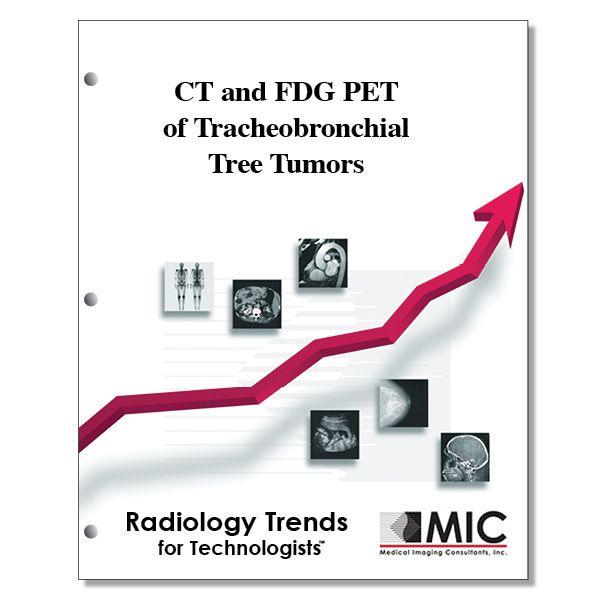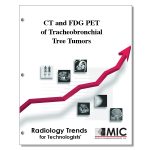

CT and FDG PET of Tracheobronchial Tree Tumors
A presentation of the many types of tracheobronchial tree tumors and their characteristics, which often differ visually and metabolically on CT and PET.
Course ID: Q00297 Category: Radiology Trends for Technologists Modalities: CT, Nuclear Medicine, PET, Radiation Therapy2.5 |
Satisfaction Guarantee |
$29.00
- Targeted CE
- Outline
- Objectives
Targeted CE per ARRT’s Discipline, Category, and Subcategory classification:
[Note: Discipline-specific Targeted CE credits may be less than the total Category A credits approved for this course.]
Computed Tomography: 2.00
Procedures: 2.00
Neck and Chest: 2.00
Magnetic Resonance Imaging: 1.00
Patient Care: 0.50
Patient Interactions and Management: 0.50
Procedures: 0.50
Body: 0.50
Nuclear Medicine Technology: 2.50
Patient Care: 0.50
Patient Interactions and Management: 0.50
Procedures: 2.00
Endocrine and Oncology Procedures: 2.00
Radiography: 1.00
Patient Care: 0.50
Patient Interactions and Management: 0.50
Procedures: 0.50
Thorax and Abdomen Procedures: 0.50
Registered Radiologist Assistant: 2.50
Procedures: 2.50
Thoracic Section: 2.50
Sonography: 0.75
Patient Care: 0.50
Patient Interactions and Management: 0.50
Procedures: 0.25
Superficial Structures and Other Sonographic Procedures: 0.25
Radiation Therapy: 2.50
Patient Care: 1.25
Patient and Medical Record Management: 1.25
Procedures: 1.25
Treatment Sites and Tumors: 1.25
Vascular-Interventional Radiography: 0.50
Procedures: 0.50
Vascular Diagnostic Procedures: 0.50
Outline
- Introduction
- Classification of Tracheobronchial Tree Tumors
- Primary Malignant Tumors
- Squamous Cell Carcinoma
- Adenoid Cystic Carcinoma
- Mucoepidermoid Carcinoma
- Carcinoid Tumor
- Sarcoma
- Secondary Malignant Tumors
- Benign Tumors
- Hamartoma
- Tracheobronchial Papillomatosis
- Lipoma
- Leiomyoma
- Neurogenic Tumors
- Other Benign Tumors
- Conclusions
Objectives
Upon completion of this course, students will:
- know important characteristics of tracheobronchial tree tumors
- recognize the imaging modality considered the standard of diagnosis for tracheobronchial tree tumors
- learn the classifications of tracheobronchial tree tumors
- identify symptoms of primary tracheobronchial tree tumors
- realize how common it is to find squamous cell carcinoma in this part of the body
- recognize the age group of patients diagnosed with tracheobronchial squamous cell carcinoma
- learn the tracheobronchial tree tumor associated with habitual cigarette smoking
- know how much more frequently squamous cell carcinoma affects men than women
- identify where squamous cell carcinoma tends to form in the tracheobronchial tree
- learn how the SUV relates to the malignant disease process
- identify the most common type of lung cancer with salivary gland origin in the central airway
- learn which primary tracheobronchial tree tumor is as common in women as it is in men
- recognize the age group of patients affected by adenoid cystic carcinoma
- learn the authors’ recommendation for improving CT visualization of ACC
- recognize where ACC tends to occur in the tracheobronchial tree
- learn that the FDG uptake of adenoid cystic carcinoma may not allow differentiation from other bronchiogenic carcinoma
- recognize how rare mucoepidermoid carcinoma is in the tracheobronchial tree
- recognize the age group of patients affected by mucoepidermoid carcinoma
- identify FDG uptake characteristics of MECs
- realize the percentage of all carcinoid tumors that are bronchial carcinoid tumors
- identify the CT appearance of carcinoid tumors
- learn primary thoracic sarcomas that may be found in the tracheobronchial tree
- know the type of metastases that occur from a variety of primary malignancies
- recognize the percentage of all airway neoplasms that are benign tumors
- learn why tumors of the tracheobronchial tree can go unrecognized for months or years
- learn the most common benign tumor of the lung
- know characteristics of endobronchial hamartoma
- recognize the part of the body most commonly affected by tracheobronchial papillomatosis
- identify risk factors of malignant transformation of tracheobronchial papillomatosis
- define lipoma
- know the imaging modality sensitive to the tissue composition of tracheobronchial lipoma
- recognize characteristics of leiomyoma
- identify the common location for intrathoracic neurogenic tumors
- learn of research which used the SUV value to differentiate between benign and malignant neurogenic tumors
- realize how CT is useful in evaluating benign tumors of the tracheobronchial tree
